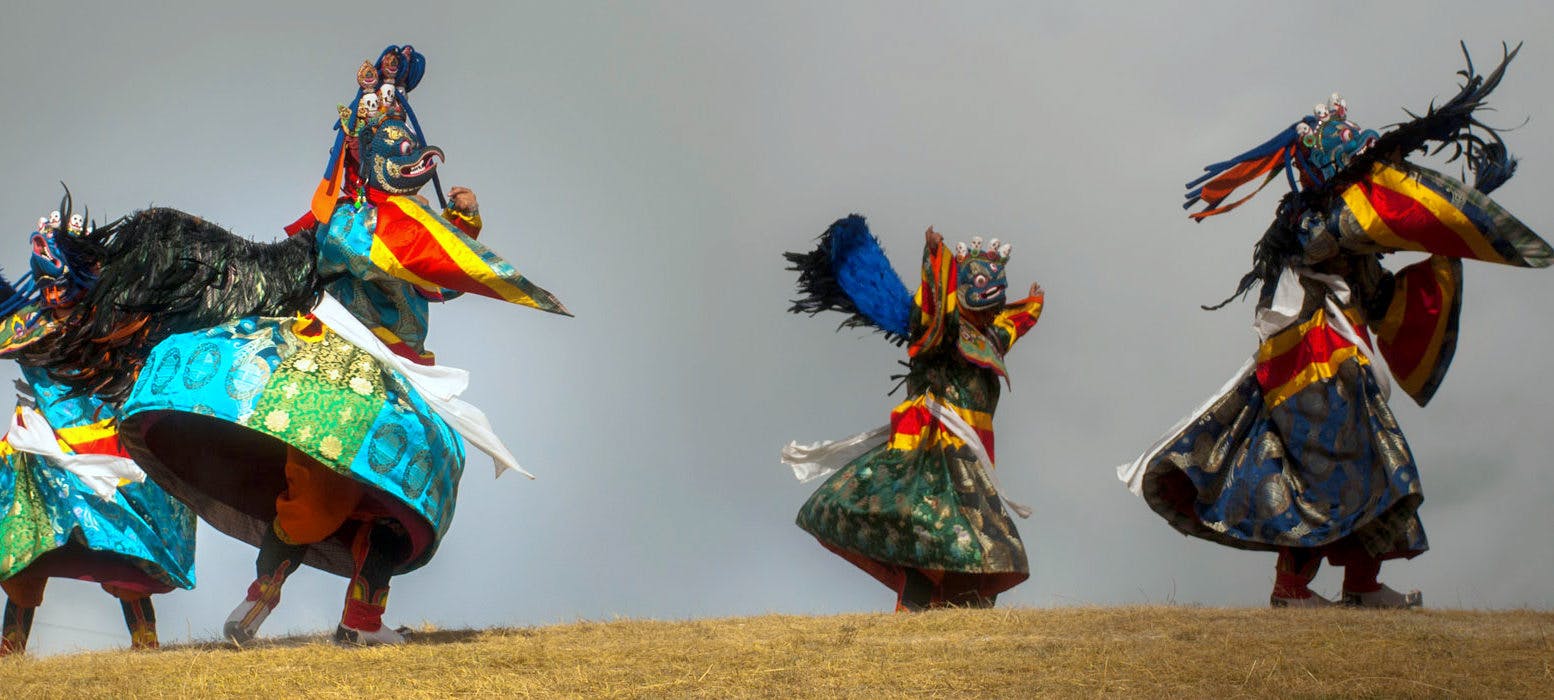Bhutan, the mystical Himalayan kingdom, is renowned for its vibrant and spiritual festivals, known locally as Tshechus. These festivals are a profound expression of Bhutanese culture, combining ancient Buddhist rituals with lively cultural performances, including the mesmerizing Cham dances, where monks and lay performers don elaborate masks and costumes. Celebrated in grandeur across the nation's monasteries, dzongs, and temples, Tshechus are not only significant religious events but also serve as communal gatherings for blessing, socializing, and showcasing Bhutanese heritage. Each festival, from the famous Paro Tshechu to the unique Punakha Drubchen, tells a story of faith, valor, and tradition, inviting travelers to immerse themselves in an experience that is deeply spiritual and visually spectacular.
Understanding Tshechus
In the intricate realm of Bhutanese culture, Tshechus stand as vibrant testimonies to the harmonious convergence of spirituality, tradition, and communal joy. These religious festivals, echoing through the sacred halls of monasteries and dzongs, transcend mere ceremonies, offering a profound insight into the Bhutanese way of life. Tshechus, pulsating with energy and devotion, bring together locals and visitors alike in a celebration that goes beyond the ordinary. As an essential guide to Bhutanese Festivals and Celebrations, this section delves into the very essence of Tshechus, unveiling the significance of these cultural phenomena. From the mesmerizing masked dances depicting tales of Buddhist lore to the sacred unfurling of Thongdrols, each festivity serves as a window into Bhutan's spiritual heritage, inviting all to witness the extraordinary blend of tradition and festivity that defines the kingdom's cultural landscape.
Paro Tsechu

Paro Tshechu is one of Bhutan's most significant and vibrant festivals, celebrated with much fervor in the picturesque Paro Valley. This annual event, held in spring, attracts both locals and tourists who come to witness the spectacular display of traditional Bhutanese culture through colorful mask dances, religious processions, and the unveiling of the giant Thangka (Thongdrel) of Guru Rinpoche. The festival not only serves as a spiritual occasion for Bhutanese people to cleanse their sins and receive blessings but also offers a unique opportunity for visitors to immerse themselves in the rich tapestry of Bhutanese tradition and community life. Paro Tshechu epitomizes the cultural and religious heritage of Bhutan, making it an unforgettable experience for all who attend.
Punakha Drubchen
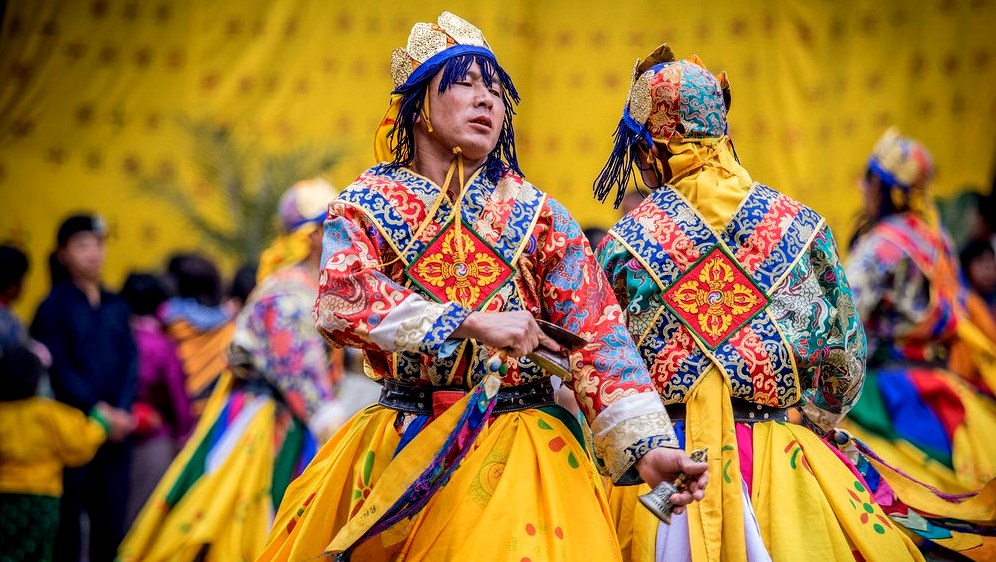
Punakha Tshechu is a deeply revered festival that takes place in the historic Punakha Dzong, one of Bhutan's most stunning architectural marvels, set against the confluence of the Pho Chhu and Mo Chhu rivers. Celebrated annually in early spring, the festival commemorates Bhutan's victory over Tibetan invaders in the 17th century, featuring a dramatic reenactment of the battle through the Punakha Drubchen. Following this, the Punakha Tshechu showcases a series of spiritual mask dances and religious ceremonies, designed to invoke blessings, promote prosperity, and teach the principles of Buddhism. This blend of historical reenactment and spiritual celebration attracts thousands of locals and tourists alike, making it a pivotal event that embodies the strength, unity, and cultural richness of the Bhutanese people.
Thimphu Tshechu
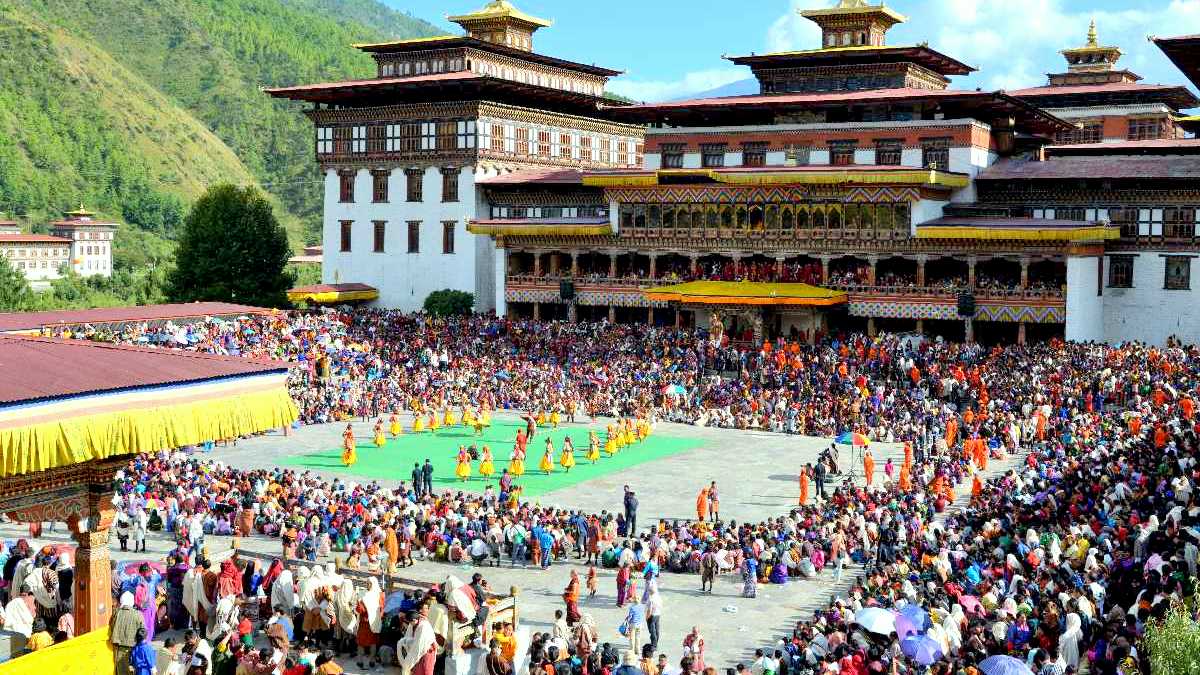
Thimphu Tshechu is the grandest festival in the capital city of Bhutan, Thimphu, symbolizing the rich cultural heritage and religious depth of Bhutanese life. Held annually in the autumn, it brings together thousands of people from all walks of life in a vibrant display of faith, joy, and communal harmony. The festival features a splendid array of mask dances, traditional music, and elaborate costumes, each narrating stories from Buddhist mythology, demonstrating moral teachings, and celebrating the victory of good over evil. The highlight is the unfurling of the Thongdrel, a massive religious painting, believed to bestow blessings on all who witness it. Thimphu Tshechu is not just a religious event but a social gathering too, offering visitors a profound insight into the Bhutanese way of life and an opportunity to partake in the spirit of Bhutanese identity and unity.
Jakar Tshechu
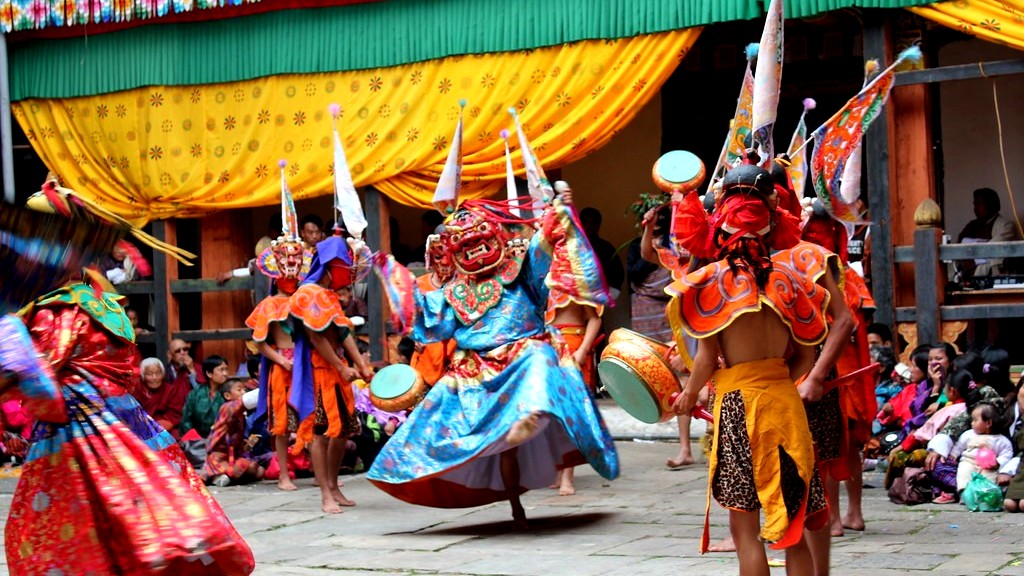
Jakar Tshechu is celebrated with great fervor in the picturesque Bumthang Valley, renowned as the spiritual heartland of Bhutan. This festival, held annually in the impressive Jakar Dzong, encapsulates the essence of Bhutanese tradition and religious devotion. It features a series of elaborate mask dances, local music, and rituals that are deeply rooted in Buddhist teachings and mythology. The performances are believed to bestow blessings upon the viewers, ward off evil spirits, and bring prosperity and peace to the community. Jakar Tshechu is a time for locals and visitors alike to come together in celebration, offering prayers and partaking in the communal spirit. The festival provides a unique opportunity to witness the rich cultural heritage of Bhutan, set against the backdrop of Bumthang's breathtaking natural beauty, making it a must-visit for those seeking to immerse themselves in the spiritual and cultural depth of Bhutan.
Ura Yakchoe Tshechu
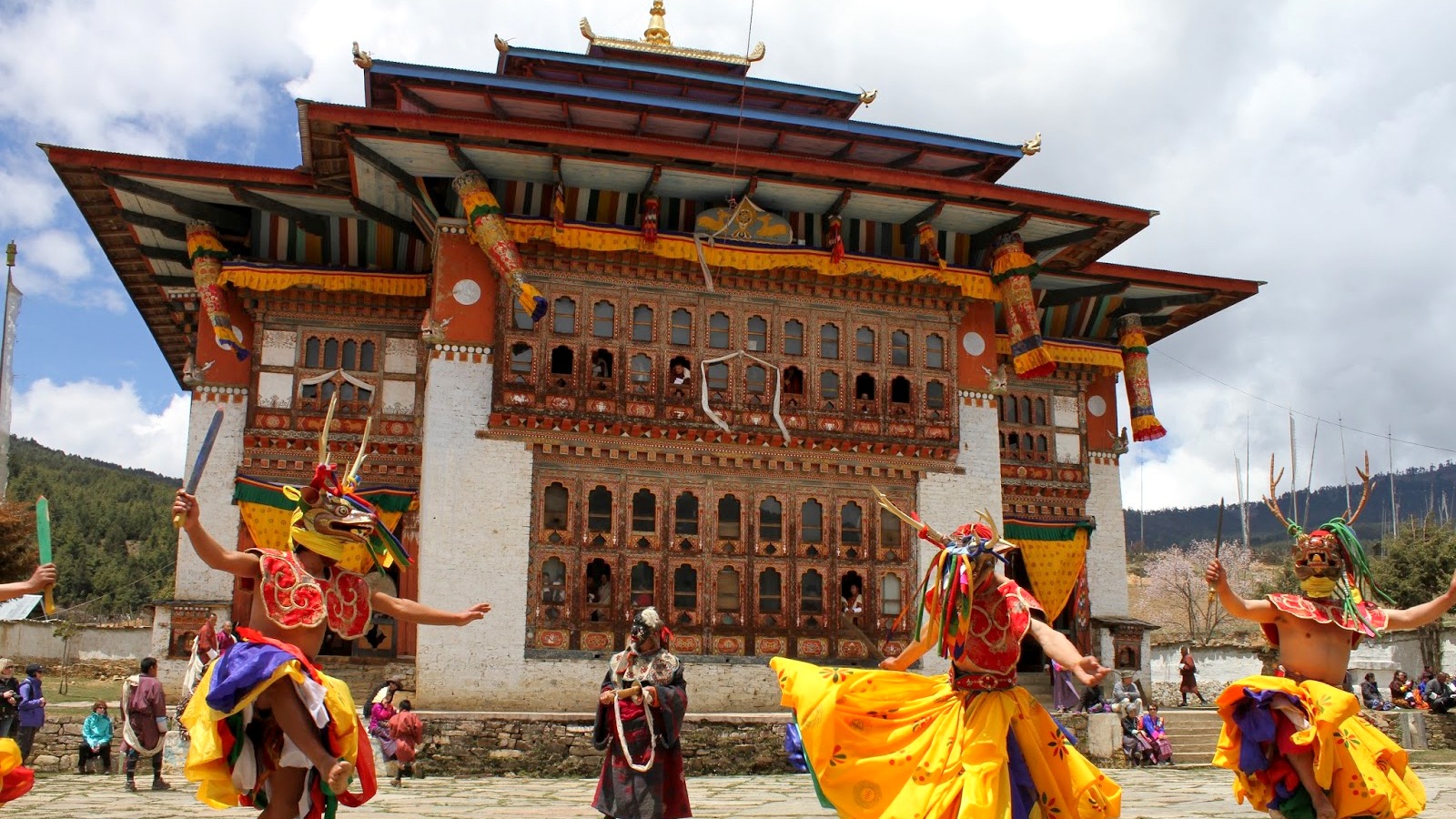
Ura Yakchoe is a captivating festival held in the serene Ura Valley of Bumthang, one of the most ancient and mystical regions in Bhutan. Celebrated in spring, this festival is renowned for its spiritual significance and cultural vibrancy. At the heart of Ura Yakchoe is the display and procession of a sacred relic, which is believed to bring blessings and protection to the community. Alongside this, the festival is marked by a series of traditional dances, music performances, and religious ceremonies, showcasing the rich tapestry of Bhutanese cultural heritage. The unique setting of the Ura Valley, with its cobblestone paths and lush landscapes, adds an enchanting backdrop to the festivities. Ura Yakchoe provides a rare glimpse into the spiritual practices and communal life of the Bhutanese people, making it a profound experience for both locals and visitors keen on delving into the depths of Bhutan's cultural and religious traditions.
Black Necked Crane Tshechu

The Black Necked Crane Festival is an annual event celebrated in the beautiful Phobjikha Valley, a key wintering ground for the rare and endangered Black Necked Cranes in Bhutan. Held in November to coincide with the arrival of these majestic birds, the festival is a testament to the deep respect and commitment the Bhutanese people have towards environmental conservation and the protection of these cranes. The festival features cultural programs, including folk songs, dances, and plays performed by local school children and community members, all dressed in vibrant costumes. One of the most captivating performances is the crane dance, which mimics the cranes' courtship dance. The event not only raises awareness about the importance of conserving the Black Necked Cranes and their habitat but also celebrates the rich cultural heritage of the region. The Black Necked Crane Festival offers a unique blend of environmental education and cultural celebration, making it a significant event for both conservationists and those interested in the traditions of Bhutan.
Bumthang Nimalung Tsechu
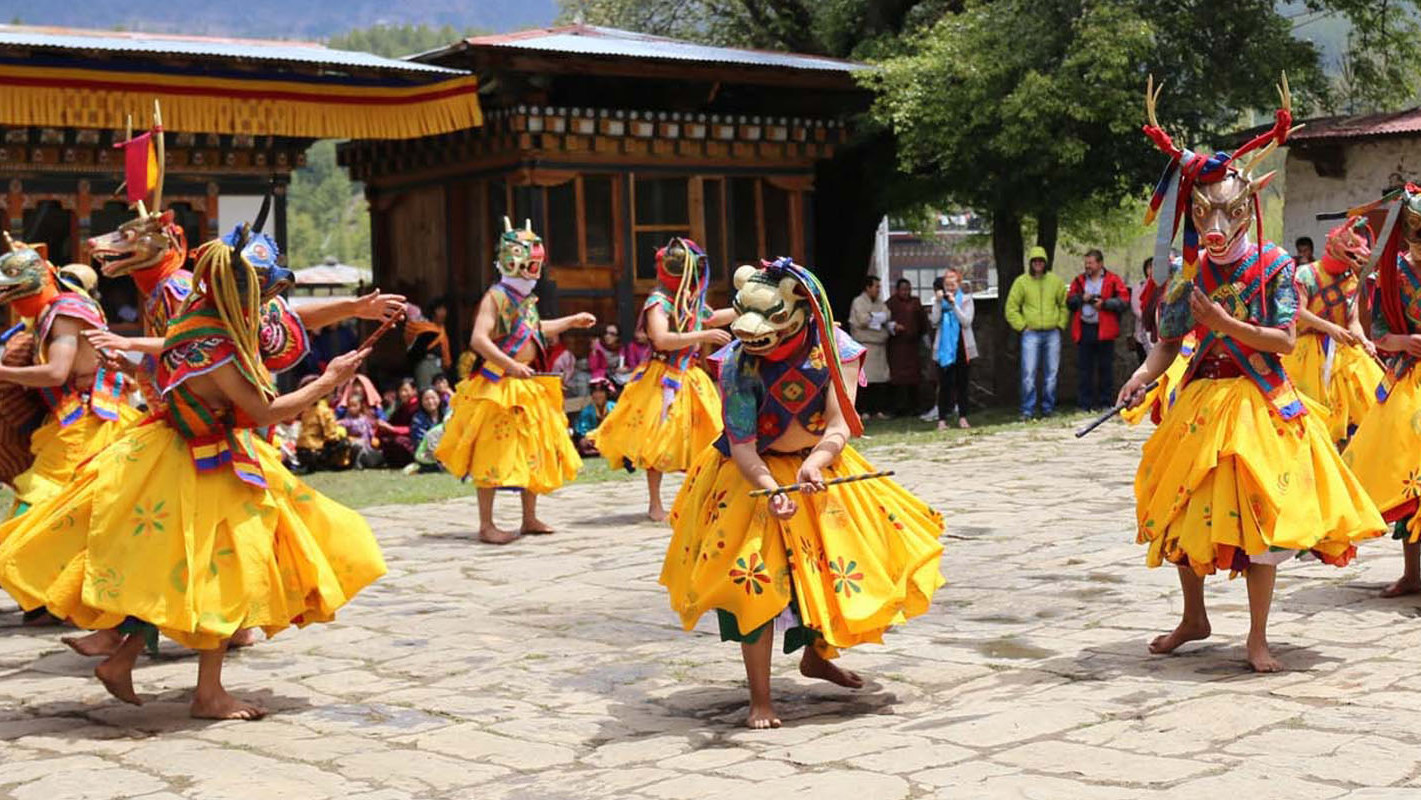
Bumthang Nimalung Tshechu is a vibrant and spiritual festival held annually at the Nimalung Monastery, located in the scenic Chumey valley of Bumthang, Bhutan's spiritual heartland. Celebrated in early summer, this festival is known for its religious significance and cultural richness, drawing both locals and tourists to participate in the festivities. The highlight of Nimalung Tshechu is the unveiling of a giant thangka (Thongdrel) of Guru Rinpoche, which is believed to confer blessings upon all who gaze upon it. Attendees are also treated to a series of mesmerizing mask dances performed by monks, which depict various Buddhist teachings and stories, serving both as a form of spiritual instruction and entertainment. These dances are accompanied by traditional music, creating a deeply immersive experience. The festival is a time of joyous celebration, where the community comes together in a display of faith, tradition, and cultural pride. Bumthang Nimalung Tshechu offers a unique opportunity to witness the living traditions of Bhutanese Buddhism and the vibrant cultural heritage of the Bumthang region.
Bhutanese Festival Food and Cuisine
Bhutanese festival food and cuisine offer a delectable window into the kingdom's rich culinary traditions, celebrated with as much fervor as the festivals themselves. Here are some highlights of the gastronomic delights you can expect to encounter during Bhutan's vibrant festivals:
- Ema Datshi: This spicy dish made from chili peppers and local cheese is a Bhutanese staple, warming and comforting, perfect for the highland climate.
- Momos: These Tibetan-style dumplings filled with either meat or vegetables are a festival favorite, often served steaming hot as a delicious snack.
- Red Rice: A nutritious, nutty-flavored staple at any Bhutanese meal, red rice pairs wonderfully with other festival dishes, absorbing flavors and adding to the overall dining experience.
- Phaksha Paa: A hearty stew made with pork, radishes, and dried chilies, offering a spicy and savory taste that is both fulfilling and emblematic of Bhutanese flavors.
- Jasha Maroo or Jasha Tshoem: A spicy chicken curry made with ginger, garlic, and chili, often accompanied by rice or buckwheat dumplings, providing a comforting, flavorful meal.
- Butter Tea: A traditional drink made from tea leaves, butter, and salt, serving as a high-energy beverage ideal for the cold weather, commonly consumed to stay energized during long festival days.
- Ara: A traditional alcoholic beverage made from distilled rice, wheat, or barley, Ara is often shared during festivals as a gesture of hospitality and celebration.
- Suja: Bhutanese butter tea that's a staple in any gathering, providing warmth and camaraderie among festival-goers.
- Zow Shungo: A dish made from leftover rice and vegetables, demonstrating the Bhutanese ethos of sustainability and respect for food.
- Goep (Tripe): Though not for the faint-hearted, goep is a traditional dish made from the stomach lining of cows or yaks, seasoned with chili and spices, showcasing the Bhutanese penchant for using every part of the animal.
These dishes not only reflect the agricultural bounty and culinary traditions of Bhutan but also the spirit of communal feasting and celebration that is at the heart of the country's festivals. Sampling these foods offers a taste of Bhutan's cultural richness, making every festival an unforgettable gastronomic journey.
Essentials Tips
For those planning to experience the vibrant festivals of Bhutan, here are some essential tips to ensure a memorable and respectful visit:
- Plan and Book Early: Accommodations and tours can fill up quickly during festival times. Book your travel arrangements and festival tickets well in advance.
- Dress Appropriately: Bhutanese festivals are often held in or near religious sites. Dress conservatively, covering shoulders and legs, to show respect for local customs.
- Learn Basic Dzongkha Phrases: Knowing a few phrases in Dzongkha, Bhutan's national language, can enhance your interaction with locals and show respect for their culture.
- Respect Local Customs: Bhutanese festivals are deeply rooted in religious traditions. Be mindful of local customs, follow the crowd's lead, and ask before taking photographs, especially of religious figures or ceremonies.
- Stay Hydrated and Protected: Bring water, sunscreen, and hats to protect against the sun, especially during outdoor festivals. The weather can be variable, so layering is also advisable.
- Try Local Cuisine: Festivals are a great opportunity to experience Bhutanese cuisine. Be adventurous and sample local dishes and snacks from vendors.
- Keep Cash Handy: While Bhutan is modernizing, many vendors at festival sites may not accept credit cards. Keep some local currency on hand for purchases and donations.
- Be Prepared for Crowds: Bhutanese festivals can attract large crowds. Be patient, respectful, and ready to embrace the communal spirit of the event.
- Engage with Locals: Festivals are an excellent time to interact with Bhutanese people. Engaging respectfully can lead to enriching experiences and deeper understanding of the culture.
- Embrace the Spiritual Aspect: Take the time to appreciate the spiritual significance of the festivals. Even if you're not religious, observing the rituals and understanding their meanings can be a profound experience.
- Environmental Consciousness: Bhutan is known for its commitment to environmental preservation. Be mindful of your environmental impact, disposing of waste properly and minimizing your footprint.
- Health and Safety: Ensure you have the necessary vaccinations and health insurance before traveling. Be aware of altitude sickness if you're not accustomed to high elevations.
Following these tips can greatly enhance your festival experience in Bhutan, allowing you to fully immerse yourself in the unique cultural and spiritual richness of this Himalayan kingdom.
Festivals of Bhutan stand as vibrant expressions of the kingdom's deep spiritual roots and rich cultural heritage. Beyond their spectacular visual appeal, these Tshechus encapsulate the essence of Bhutanese identity, offering a window into the soul of this Himalayan paradise. They are a testament to the country's unwavering commitment to preserving its traditions and spiritual practices, while fostering community spirit and global cultural exchange. For travelers and culture enthusiasts alike, attending a Bhutanese festival is not just an event but a profound journey into the heart of Bhutan's spiritual and communal life.
FAQs for Festivals in Bhutan
Q: What makes Bhutanese festivals unique?
A: Bhutanese festivals, known as Tshechus, are unique for their blend of spirituality, tradition, and community celebration. Each festival is a vibrant expression of Bhutanese culture, featuring colorful masked dances, religious ceremonies, and a deep connection to the nation's rich heritage.
Q: Which are the most significant Bhutanese festivals to attend?
A: Some of the most significant festivals include the Paro Tsechu, Thimphu Tshechu, Punakha Drubchen, and Jakar Tshechu. These celebrations offer a captivating experience with their distinct rituals, dances, and cultural significance.
Q: How can I plan my trip to coincide with Bhutanese festivals?
A: Planning your trip to Bhutan during festival season requires careful consideration. Consult our experts at Amen Bhutan Tours and Treks to ensure your itinerary aligns with the festival dates. It's advisable to book accommodations and travel well in advance.
Q: What should I wear during Bhutanese festivals?
A: Traditional Bhutanese attire is recommended during festivals. Men wear a Gho, and women wear a Kira. These garments not only show respect for the culture but also enhance your festival experience.
Q: Are Bhutanese festivals open to tourists?
A: Yes, Bhutanese festivals are open to tourists, and attending them is a wonderful way to immerse yourself in the local culture. However, it's essential to follow cultural etiquette and be respectful during religious ceremonies.
Q: How can Amen Bhutan Tours and Treks enhance my festival experience?
A: Our expert guides provide in-depth insights into each festival, ensuring you understand the rituals and significance. We offer seamless travel arrangements, comfortable accommodations, and a curated experience to make your festival journey memorable.
Q: Are there specific customs to be aware of during Bhutanese festivals?
A: Respectful behavior is crucial during festivals. It's customary to circumambulate religious structures in a clockwise direction and to follow the guidance of your guide regarding appropriate conduct during ceremonies.
Q: What is the significance of Thongdrols in Bhutanese festivals?
A: Thongdrols are large religious scrolls displayed during festivals. The mere sight of a Thongdrol is believed to cleanse sins and bring blessings. Witnessing the unveiling of a Thongdrol is a highlight of many festivals.
Q: How can I capture the best moments during Bhutanese festivals?
A: Photography is usually allowed, but it's essential to ask for permission before taking pictures of individuals. Be discreet and respectful, and consider hiring a local photographer for professional insights.
Q: Can Amen Bhutan Tours and Treks customize festival tours based on individual preferences?
A: Absolutely! We specialize in crafting personalized itineraries to ensure your festival experience aligns with your preferences. Whether you seek a more spiritual journey or a focus on cultural aspects, we tailor our tours to your needs.
If you are looking for tour packages in Bhutan please click here
If you need any further information, please contact us, Email: at [email protected] , Phone (Whatsapp or Viber) +975-1755-6636
